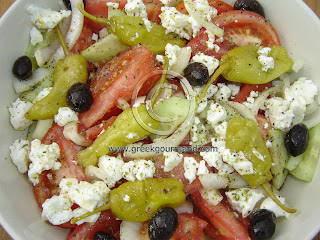Village Greek Salad (Χωριάτικη Ντοματοσαλάτα)

Village Greek salad in all its glory - Click to Enlarge Image Exactly when the tomato arrived in Greece is a matter of conjecture; there are various apocryphal anecdotes and references but nothing definitive. One thing is certain; it arrived sometime after Columbus returned from the New World in 1493. The tomato is native to the Americas and was introduced to Europe after the Discovery made by the great 15 th Century navigator on his celebrated voyage across the Atlantic . If Christopher Columbus was of Greek origin as some claim, it may have arrived in Greece earlier than commonly supposed. In any case, the tomato qua tomato has been a part of European and Greek recipes for no more than a few centuries all told. It is downright astonishing how this species of nightshade spread and insinuated itself into the national cuisines of the European continent in such a relatively short time. After all, where would Italian cooking be without the tomato? How about the Spanish food fig...
